The Pacuare River and Hydroelectric Peril
The balance of wilderness conservation and industrial ambition in Costa Rica
By Boreal River Guide – Ty Smith, MSc
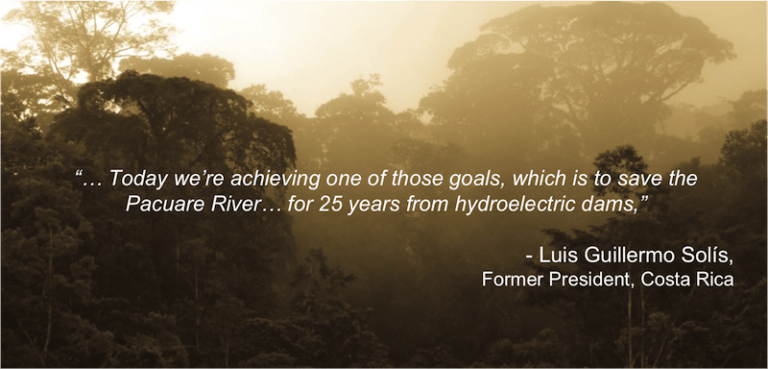
Pacuare: The Quintessential Jungle River
The Pacuare River is a world famous destination for whitewater paddlers and eco-tourists. The river boasts warm water, dense virgin tropical rainforest, abundant wildlife, and waterfalls-galore. It’s hard to overstate the lushness of vegetation along the Pacuare, with incredibly bio-diverse plant and tree species covering the steep surrounding hills and canyon walls.
The Pacuare River valley is home to the Cabécar Indigenous people and is part of their ancestral territory.
The river itself is beautiful, characterized by clear blue-tinted water and round boulders. These shift during floods, causing the rapids to morph and form new paddling lines.
Most importantly, the Pacuare is a free-flowing river that you can paddle year-round.
“It’s like the Disney Land of rivers with awesome rapids, waterfalls coming in from everywhere, and giant blue butterflies, toucans, and sloths.
It’s also just accessible enough that we can get there fairly easily, but remote enough that it’s stayed relatively pristine. And it’s perfect for whitewater paddling with groups, with continuous, technical, and fun rapids that are not too difficult. It’s a highly runnable river! ”
– Danny Peled, Founder of Boreal River Adventures
Paddling the Pacuare
The Pacuare flows from the Talamanca Mountains, the interior “spine” of southeastern Costa Rica, to the Caribbean coast. It ranks in the top 10 of most lists of premiere rafting destinations in the world.
Along it’s 180km (112mi) journey it drops 1,280m (4,200ft) and forms 6 distinct paddling sections:
- Headwaters (only accessible by hiking)
- The Top (class II-III)
- Upper Upper (class II-III+),
- The Upper (class IV-V)
- The Lower (class III-IV)
- The Coastal Lowlands (flat water)
The 37km (23mi) “Lower Pacuare” is the most popular rafting section in Costa Rica. It contains lots of continuous rapids including class IV “Dos Montañas”, “Cimarrones”, and “Upper and Lower Huacas”.
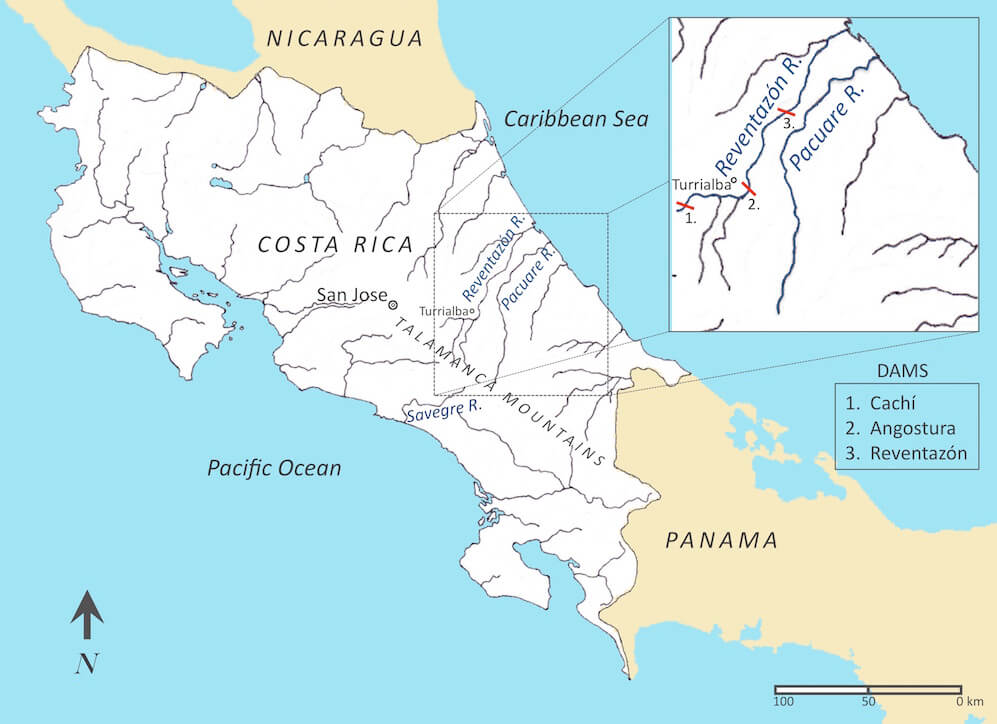
Map of Costa Rica with the Pacuare, Reventazón and Savegre Rivers indicated.
Hydroelectric Threat to the Pacuare River
Costa Rica’s national energy company has prized the vast hydroelectric potential of the Pacuare for decades. But so far, a stalwart resistance has successfully saved the river from development.
Currently, a presidential decree protects the Pacuare from larger hydroelectric projects (>500KW) until 2030. But, this fragile truce between industry and river activism could be overruled by a new government before then.
The ultimate conservation goal is to establish lasting, legal protection for the Pacuare River. Until then, the future of Costa Rica’s best and most sustainable whitewater rafting, and the home of the indigenous Pacuare Cabécar people, remains uncertain.
“… for more than 20 years they’ve planned a dam on the Pacuare. But we’ve put up a very strong fight, and we’ve stopped them a little bit. But then the government changes.”- Kerlin Salazar Pérez, Cabécar person
A Fight Worth a Dam
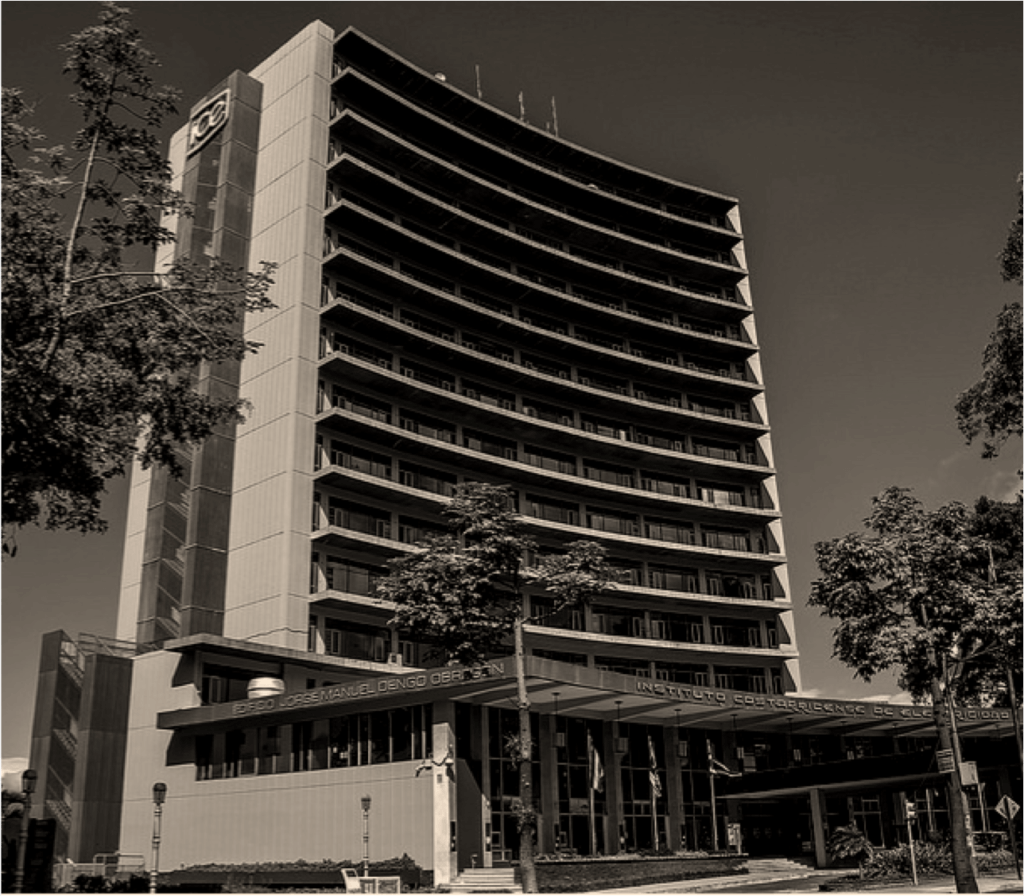
The Instituto Constarricence de Electricidad (ICE) head office in San Jose, CR.
Several parties are concerned with the building of a dam on the Pacuare River:
The Cabécar Indigenous People
Damming the Pacuare River will flood the home of the Cabécar people and displace them from those areas. They stand to lose much of their traditional way of life, including access to the fish, edible and medicinal plants, animals, and adventure tourism jobs they rely on for subsistence. The dubious economic benefits and power supply of (CR currently has a power surplus) a new dam must be weighed against the environmental, social, cultural, and economic costs to the local Cabécar people.
Instituto Constarricence de Electricidad (ICE)
ICE is Costa Rica’s government-owned electrical power monopoly. Since the 1940’s they have a constitutional mandate to investigate and develop energy resources for Costa Rica. Since 1986, ICE has proposed damming the Pacuare River to generate power.
Citizens of Turrialba and surrounding communities
Turrialba is the closest city to the put-ins for the Pacuare River. It is the staging ground for most adventure tourism activities involving the river. In 2005, the citizens of Turrialba held a constitutional vote for the future of their community. 97% voted to not dam the Pacuare.
Adventure Tourism Community
The Pacuare adventure tourism community includes Costa Rican and international companies and guides. They focus on whitewater rafting, kayaking and canoeing, zip-lining and trekking. This industry also sustains and is supported by several eco-lodges. And the impact to the local economy extends far beyond the outdoor activities, to transportation, hospitality, and local suppliers.
Amigos del Río Pacuare
Made up of members from the above groups, except ICE, the “Friends of the Pacuare River” have been the prominent voice contesting dams on the Pacuare. They organized the plebiscite in Turrialba and advocate tirelessly with the Costa Rican government to protect the river .
The Hydroelectric Conundrum
Let’s take a moment to talk about why dams might not be a good idea. Dams mitigate floods, store drinking water, and generate power. As long as the water source doesn’t dry up (e.g. when a glacier melts away to nothing) they are a renewable resource. However, for years the term renewable, as it relates to dams, has been used interchangeably (or confused) with “green” power.
At Boreal River Adventures we rely on rivers for our livelihood. Our bias against dams goes beyond the aesthetic difference between a dry riverbed and a vibrant free-flowing river. However, let’s objectively examine both sides of the argument and then discuss some of the main points.
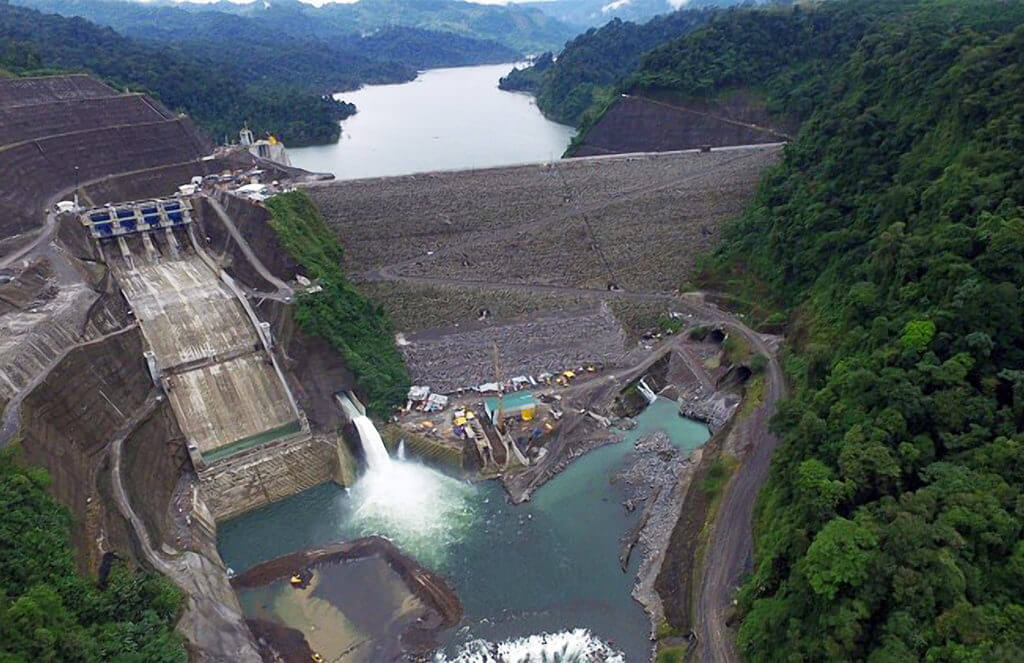
The Reventazon Dam (305.5MW). The largest dam in Central America
Pros of dams
- Renewable resource
- Large dams can generate substantial power
- Creates many jobs during the building of the dam and power line infrastructure
- Creates operational and maintenance jobs once built
- Power can be produced “on demand”
- Can prevent flooding
- Does not involve fossil fuels or uranium during power generation
- Can provide a source of stored drinking water
- Can maintain a “healthy” river ecosystem via several methods (e.g. fish ladders, continuous base flow)
Cons of dams
- Destruction and disruption of intact wilderness
- Organic matter decay releases greenhouse gasses
- Negative impact on adventure tourism activities
- Fish kills impact ecosystem balance and fishery stocks
- Change in river temperature profile forces species to adapt or die
- Invasive species may be better adapted to post-dam conditions and move into ecosystem
- Dam failures occur (particularly in active tectonic areas like Costa Rica)
- Large tracts of land (read virgin rainforest of the Pacuare) are clear cut to connect power lines to the dam
- Flooding can occur (e.g. reservoir filling, high volume releases to protect dam structural integrity)
- Earthquakes have been linked to the incredible mass of water withheld by some large dams, which also threatens the stability of the dam
- Sediment buildup decreases the efficiency of power generation. This negatively impacts the river when released in large flushing events (like clear water turning to de-oxygenated mud slurry).
Although dams provide important services like power generation and crop irrigation, they can also cause environmental and cultural problems. When weighed against each other it seems inappropriate to call dams “green energy”. This is especially true when you consider the growing capability and popularity of today’s renewable power options. For example, in 2012 governments and businesses installed 75 gigawatts of wind and solar power, compared to 30 gigawatts of hydropower. (Source: International Rivers)
In general, Costa Rica is a challenging country in which to build dams. The volcanic central mountain ranges are formed by the Cocos tectonic plate sinking under the Caribbean Plate. This active tectonic zone results in volcanic eruptions and earthquakes. Next consider that a tropical rainforest climate is already prone to landslides and flooding. The long-term structural integrity of large dams is far from guaranteed.
Fortunately for the Pacuare River, the argument against a dam is stronger because of lessons hard-learned from other ICE projects. These lessons include people being displaced, methane gas being emitted from decaying organic matter, and fisheries have been depleted by sediment and debris flushes. The fact that Costa Rica currently has a power surplus, also makes further dam building unnecessary.
Find out more about the environmental impacts of dams from the organization International Rivers.
Timeline: Dams and Conservation
1986 – ICE submitted a proposal to build a dam on the Pacuare River near the end of the Lower Section at the rapid Dos Montañas. The site was geographically ideal as sheer rock walls formed a natural constriction.
1991 – Before the start of building, a powerful 7.5 earthquake, centered in nearby Puerto Limón, shook the area. It destabilized the dam site’s bedrock, causing fissures and forced ICE to abandon the project.
1998 and 2000 – ICE completed 2 dams on the Reventazón River, north of the Pacuare. The 177MW Angosturas dam (2000) destroyed a major section of raftable whitewater. This caused most commercial rafting companies to shift to the Pacuare River.
2001 – The Amigos del Río Pacuare river advocacy group was formed. This was in response to an increased appetite for hydroelectric development by the Costa Rican Government. They feared the Pacuare River would share the fate of the Reventazón, .
2005 – The rafting industry boomed in the Turrialba area, and public sentiment seemed strongly in favour of river conservation. To capitalize, the Amigos del Río Pacuare helped organize a plebiscite (referendum). The Turrialba citizens voted 97% to ban dams on the Pacuare River. Although this vote could not legally prevent a future dam, it was a clear and persuasive expression of the public will.

2006 – Having given up on the Dos Montañas Site, ICE proposed building a dam on the Upper Upper section of the Pacuare. The reservoir for the dam would flood a Cabécar community and displace them from ancestral lands.
2014 – The Amigos del Pacuare organized a meeting with the new CR government to negotiate protecting the Pacuare. This led to President Luis Guillermo Solís’ signing a decree to protect the Pacuare and Savegre Rivers from large dams for 25 years.
2016 – The 305.5MW Reventazón Dam was completed, becoming the largest dam in Central America.
2017 – The Costa Rican Government passed the Wetlands Protection Act in March.
2017 – In June the Savegre River became a UNESCO World Heritage Site. It boasts wondrous biodiversity, with 59% of Costa Rica’s birds, 54% its mammals, and 20% of its flora.

The Reventazón Reckoning

The Reventazón Dam Reservoir after being filled. The treetops protruding from the water hint at substantial decaying organic matter below the surface.
The Reventazón River, a large watershed north of the Pacuare, was once a hub for world-class whitewater paddlers. In fact, many northern hemisphere Olympic kayakers would train on the Reventazón during their winter.
In 1991, the World Championship for Whitewater Rafting was held on the Reventazón for a raucous 15 days of high-water racing.
Unfortunately, the former majesty of the Reventazón has been chipped away with 3 successively larger dams. By the second dam’s completion, much of the worthwhile rafting was dry and most companies had moved away. With the completion of the Reventazón Dam, the largest in Central America, no rafting was viable without a scheduled release. This now happens rarely and is not the main business of the companies involved. Besides the periodically-defibrillated flicker of a pulse, the Reventazón is essentially dead.
What’s more, problems of excessive sediment load and organic matter decay plague the Reventazón Dam.
Before filling the dam reservoir, ICE was required to remove all organic matter. This wasn’t done. As a result, the substantial drowned vegetation below the surface continuously releases greenhouse gasses as it decays.
High sediment loads in the river have been connected with improper agricultural practices and heavy rain events (not uncommon in a rainforest). The sediment backs-up behind the dam and can cause the power generators to work less efficiently. To clear out the sediment the Reventazón Dam Operators perform several large flushing releases per year. During these releases, a muddy slurry replaces the base flow downstream. This causes a large death toll among the fish population, as their gills clog with sediment.
The Reventazón Dam is not a picture of environmentally conscientious choices. It should serve as a stark vision of the future of the Pacuare River, if a dam is approved.
El Presidente Wades Into The Pacuare
There are few environmental advocacy stories with a better climatic moment than the battle for the Pacure. President Solís’ flare for the dramatic, no doubt played a part.
On August 29th, 2015 a festival was held on the Pacuare River celebrating the 10-year anniversary of Turrialba’s historic vote. Costa Rican President Luis Guillermo Solís, his wife, daughter, and Environment Minister Edgar Gutiérrez, all went rafting to see the Pacuare first-hand.
Afterward, a forum was held with all vested parties including members from The Cabécar Nation, Amigos del Rio Pacuare, Citizens of Turrialba, Adventure Tourism Professionals, and members of the Costa Rican Government (ICE being an extension of the govt.).
Environment Minister Edgar Gutiérrez prepared the crowd saying, “It’s really a great day because we managed to demonstrate that people do count. The old way of doing politics, of doing government by imposition is over.”
He then highlighted that Costa Rica now provides electricity to 99.4% of the country “[without] burning one litre of fuel to generate [it].”
Gutiérrez noted that this fossil fuel-free power came at the cost of several hydroelectric projects, including the “immense environmental impact” of the Arenal dam. Built in northwestern CR, the Arenal generates 12% of the nation’s power. But, with its reservoir full, it also tripled the size of Lake Arenal.
The forum culminated in President Solís asking the audience to form a circle with their chairs around him. Accompanied by Minister Gutiérrez he then produced a decree: dams would be banned from the Pacuare and Savegre rivers for 25 years. After the two diplomats signed the document, Solís held it above his head and shouted, “For Costa Rica!”
Encouragement for Future Conservation
As you might imagine, the elated audience applauded and cheered. It was a day that some had been fighting toward for several decades, and they enjoyed the moment.
President Solís closed with some encouraging words for conservation and a call for continued action:
“I’m going to tell you this, the reality today conspires against the damming of water,” he said. “The investors who want to produce electricity in Costa Rica aren’t thinking of dams because they know that climate change doesn’t facilitate that. But even more than that, the communities aren’t going to permit it.”
“So, congratulations for what you’ve accomplished so far, but what’s left to do is much more. What we’re doing today is a testimony, nothing more, a testimonial expression of what this country can do in the future.”
A (Tentatively) Hopeful Future
In the years following the historic victory for the Pacuare, 4 events occurred that give hope for its future.
- The Raventazón Dam was completed and ran into problems with greenhouse gas emissions. These were due to organic matter decaying in its reservoir, and excessive sediment build-up and release in large flushing events. This environmental and economic (adventure tourism, fishing) damage has not gone unnoticed. Those who may have supported a Pacuare Dam now have a glaring example of what could happen to their river. And those who oppose it have further justification for their cause.
- Costa Rica passed the National Wetlands Protection Act on March 6, 2017. This aims to preserve and revitalize the nation’s rivers, lakes, mangroves, other wetlands, and their biodiversity. The Act combines efforts from the Ministry of the Environment, the National System of Conservation Areas, and the United Nations Development Program. It’s part of a national strategy to conserve and sustainably manage Costa Rica’s wetlands. Although no permanent legal protection has been established, this policy paves the way for that to happen.
- The Savegre River became a UNESCO World Heritage Site on June 15, 2017. This was a near-immediate example of policy leading to action. The government must now ensure that the Biosphere Reserve maintains all the characteristics that made the UNESCO designation possible. However, it does not represent any substantial changes for the communities involved. A similar status might be a good fit for the Pacuare River Valley. There are several active communities interested in environmental protection, while keeping access to the “sustainable” use of their land and natural resources.
- Lastly, on April 1, 2018 Carlos Alvarado Quesada was elected President of Costa Rica. He is a member of the same party as Solís (center-left Citizens’ Action Party); it is hoped he will be just as supportive of the Pacuare. With a government favourable toward conservation until at least 2022, the Pacuare (and Savegre) Decree should go unaltered.
Friends of the Pacuare
After years of effort, the public and governmental will are finally aligned, and legal policies are in place to safeguard the Pacuare for generations to come.
It’s a very exciting time to be a “Friend of the Pacuare”; the future of paddling and experiencing this beautiful river has never been more hopeful.
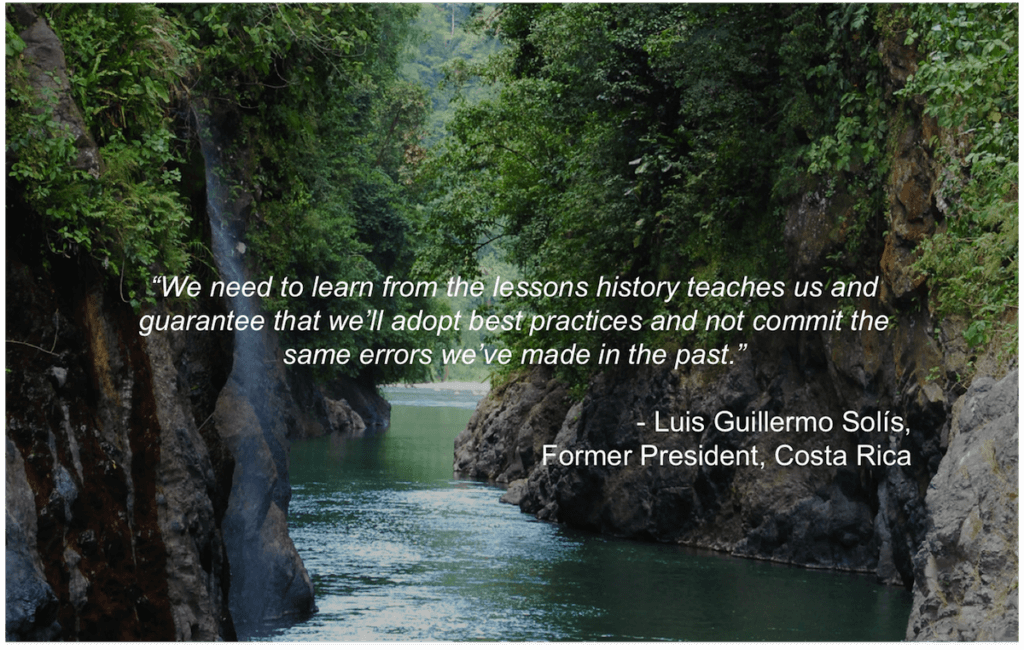
What You Can Do
If you want to help protect the Pacuare, there are a few things you can do.
Stay informed. Check back here for updates on the fight for the Pacuare.
Take a stand. Even if you’re not from the area, sign a petition or send a letter to a government official. It can make a difference, especially if you represent someone bringing tourism to the area.
Support adventure tourism. Take part in, and tell others about, sustainable adventure activities. Help the companies that want to keep the area natural. Plus, it’s a healthy and bold way to experience the world!
Experience the Pacuare
Here are 2 great options for you to visit the Pacuare River (with us ☺ ) this winter:
Costa Rica Packrafting
Join a jungle expedition and explore the Pacuare on the 9-day Costa Rica Packrafting trip. You’ll paddle your own packraft, camp on the riverside, hike in the rainforest, and gain skills—far from the crowds.
Costa Rica Wilderness First Responder Course
Earn international certification as a Wilderness First Responder at an eco camp on the banks of the Pacuare. For backcountry leaders, rescue teams, and anybody who travels remotely, you’ll gain the confidence and abilities to manage medical problems in the backcountry.
Boreal River founder, Danny Peled, will guide and instruct the Costa Rica trips. He spent 5 seasons river guiding in Costa Rica through his twenties and fell in love with the Pacuare. Boreal River has been running training and adventure trips on the Pacuare since 2013, with our local partners and guides.

